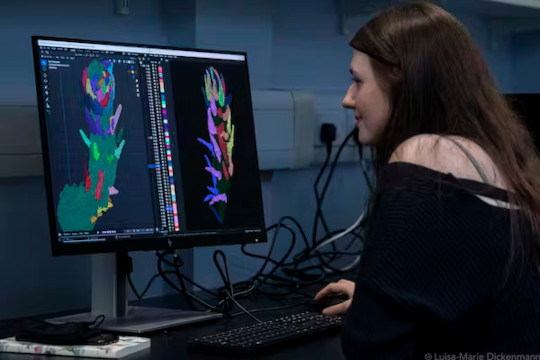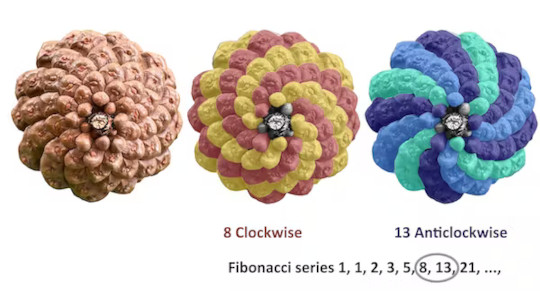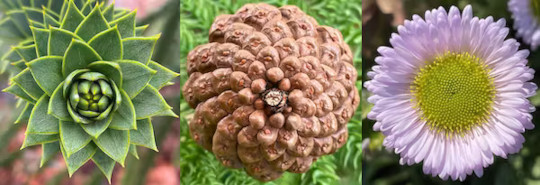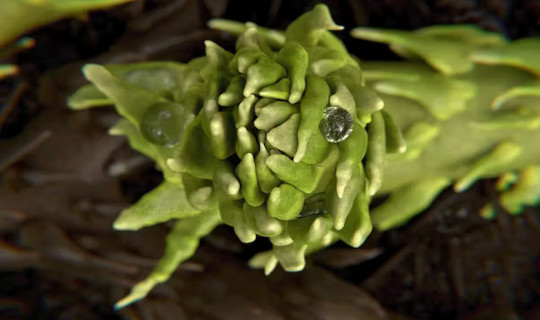The spiky branches of a monkey puzzle tree. Joshua Bruce Allen/Shutterstock
If your eyes have ever been drawn to the arrangement of leaves on a plant stem, the texture of a pineapple or the scales of a pinecone, then you have unknowingly witnessed brilliant examples of mathematical patterns in nature.
What ties all of these botanical features together is their shared characteristic of being arranged in spirals that adhere to a numerical sequence called the Fibonacci sequence. These spirals, referred to as Fibonacci spirals for simplicity, are extremely widespread in plants and have fascinated scientists from Leonardo da Vinci to Charles Darwin.
Such is the prevalence of Fibonacci spirals in plants today that they are believed to represent an ancient and highly conserved feature, dating back to the earliest stages of plant evolution and persisting in their present forms.
However, our new study challenges this viewpoint. We examined the spirals in the leaves and reproductive structures of a fossilised plant dating back 407 million years. Surprisingly, we discovered that all of the spirals observed in this particular species did not follow this same rule. Today, only a very few plants don’t follow a Fibonacci pattern.

Holly-Anne Turner, first author of the study, creating digital 3D models of Asteroxylon mackiei at the University of Edinburgh. Luisa-Marie Dickenmann/University of Edinburgh, CC BY-NC-ND
What are Fibonacci spirals?
Spirals occur frequently in nature and can be seen in plant leaves, animal shells and even in the double helix of our DNA. In most cases, these spirals relate to the Fibonacci sequence – a set of numbers where each is the sum of the two numbers that precede it (1, 1, 2, 3, 5, 8, 13, 21 and so on).
These patterns are particularly widespread in plants and can even be recognised with the naked eye. If you pick up a pinecone and look at the base, you can see the woody scales form spirals that converge towards the point of attachment with the branch.
At first, you may only spot spirals in one direction. But look closely and you can see both clockwise and anticlockwise spirals. Now count the number of clockwise and anticlockwise spirals, and in almost every case the number of spirals will be integers in the Fibonacci sequence.

The same pinecone colour coded to show 8 clockwise and 13 anticlockwise spirals. 8 and 13 are consecutive numbers in the Fibonacci series. Sandy Hetherington, Author provided
This particular instance is not an exceptional case. In a study that analysed 6,000 pinecones, Fibonacci spirals were found in 97% of the examined cones.
Fibonacci spirals are not just found in pine cones. They are common in other plant organs such as leaves and flowers.
If you look at the tip of a leafy shoot, such as that of a monkey puzzle tree, you can see the leaves are arranged in spirals that start at the tip and gradually wind their way round the stem. A study of 12,000 spirals from over 650 plant species found that Fibonacci spirals occur in over 90% of cases.
Due to their frequency in living plant species, it has long been thought that Fibonacci spirals were ancient and highly conserved in all plants. We set out to test this hypothesis with an investigation of early plant fossils.

Examples of living plants with Fibonacci spirals. From left to right: spirals in leaves of a monkey puzzle trees, a pine cone and in the flower of a seaside daisy. Sandy Hetherington, Author provided
Non-Fibonacci spirals in early plants
We examined the arrangement of leaves and reproductive structures in the first group of plants known to have developed leaves, called clubmosses.
Specifically, we studied plant fossils of the extinct clubmoss species Asteroxylon mackiei. The fossils we studied are now housed in museum collections in the UK and Germany but were originally collected from the Rhynie chert – a fossil site in northern Scotland.
We took images of thin slices of fossils and then used digital reconstruction techniques to visualise the arrangement of Asteroxylon mackiei’s leaves in 3D and quantify the spirals.
Based on this analysis, we discovered that leaf arrangement was highly variable in Asteroxylon mackiei. In fact, non-Fibonacci spirals were the most common arrangement. The discovery of non-Fibonacci spirals in such an early fossil is surprising as they are very rare in living plant species today.

Life reconstruction of fossil Asteroxylon mackiei. Matt Humpage/Northern Rogue Studios, CC BY-NC-ND
Distinct evolutionary history
These findings change our understanding of Fibonacci spirals in land plants. They suggest that non-Fibonacci spirals were ancient in clubmosses, overturning the view that all leafy plants started out growing leaves that followed the Fibonacci pattern.
Furthermore, it suggests that leaf evolution and Fibonacci spirals in clubmosses had an evolutionary history distinct from other groups of living plants today, such as ferns, conifers and flowering plants. It suggests that Fibonacci spirals emerged separately multiple times throughout plant evolution.
The work also adds another piece to the puzzle of a major evolutionary question – why are Fibonacci spirals so common in plants today?
This question continues to generate debate among scientists. Various hypotheses have been proposed, including to maximise the amount of light that each leaf receives or to pack seeds efficiently. But our findings highlight how insights from fossils and plants like clubmosses may provide vital clues in finding an answer.![]()
About The Author
Sandy Hetherington, Plant Evolutionary Biologist, The University of Edinburgh and Holly-Anne Turner, PhD Candidate, Palaeobotany, University College Cork
This article is republished from The Conversation under a Creative Commons license. Read the original article.
Books on The Environment from Amazon's Best Sellers list
"Silent Spring"
by Rachel Carson
This classic book is a landmark in the history of environmentalism, drawing attention to the harmful effects of pesticides and their impact on the natural world. Carson's work helped to inspire the modern environmental movement and remains relevant today, as we continue to grapple with the challenges of environmental health.
Click for more info or to order
"The Uninhabitable Earth: Life After Warming"
by David Wallace-Wells
In this book, David Wallace-Wells offers a stark warning about the devastating effects of climate change and the urgent need to address this global crisis. The book draws on scientific research and real-world examples to provide a sobering look at the future we face if we fail to take action.
Click for more info or to order
"The Hidden Life of Trees: What They Feel, How They Communicate?Discoveries from A Secret World"
by Peter Wohlleben
In this book, Peter Wohlleben explores the fascinating world of trees and their role in the ecosystem. The book draws on scientific research and Wohlleben's own experiences as a forester to offer insights into the complex ways that trees interact with one another and the natural world.
Click for more info or to order
"Our House Is on Fire: Scenes of a Family and a Planet in Crisis"
by Greta Thunberg, Svante Thunberg, and Malena Ernman
In this book, climate activist Greta Thunberg and her family offer a personal account of their journey to raise awareness about the urgent need to address climate change. The book provides a powerful and moving account of the challenges we face and the need for action.
Click for more info or to order
"The Sixth Extinction: An Unnatural History"
by Elizabeth Kolbert
In this book, Elizabeth Kolbert explores the ongoing mass extinction of species caused by human activity, drawing on scientific research and real-world examples to provide a sobering look at the impact of human activity on the natural world. The book offers a compelling call to action to protect the diversity of life on Earth.






















